
Although light allows us to see the world around us, it turns out that we may not always be getting the full picture. There are three fundamental aspects of light: brightness, colour and polarisation. As humans, we tend only to be familiar with the first two because while we can tell differences between light and dark and discriminate colours, we cannot see the polarisation of light. However, there are animals that can, whose eyes give them the ability to see the polarisation of light alongside its colour and brightness. So what is polarisation vision and what information can it give to these animals that is hidden from our eyes?
While brightness is simply a measure of how much light is present, both colour and polarisation are properties of light behaving as a wave. Recall from physics lessons that light, rather than travelling along a straight direct path, oscillates back and forth as it moves through space (figure 1). The wavelength of light, which we perceive as colour, is defined by the separation between peaks of the wave and polarisation is a geometrical description of that wave. In the example of figure 1, the light wave is drawn as oscillating up and down in the plane of the page as it travels from left to right. In fact, the oscillation can be in any direction; so it could be coming into and out of the page, or at any angle in between (figures 2 and 3).
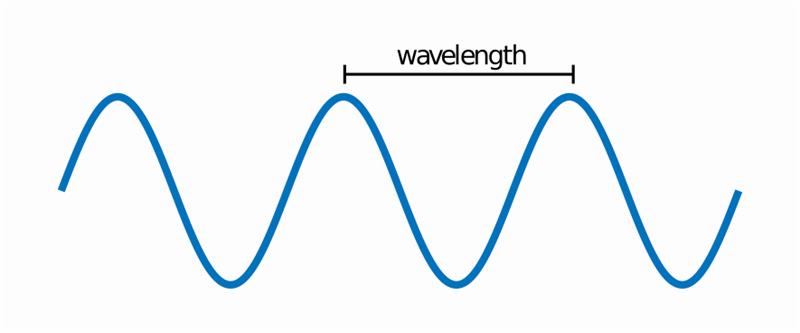
Figure 1: Light behaves as a wave, oscillating back and forth rather than taking a straight path as it travels through space
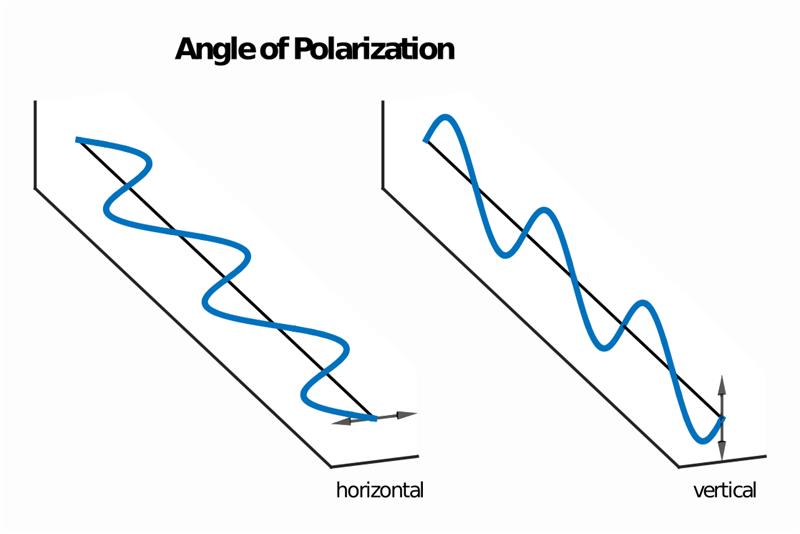
Figure 2: The oscillation can be in any direction, from horizontal to vertical
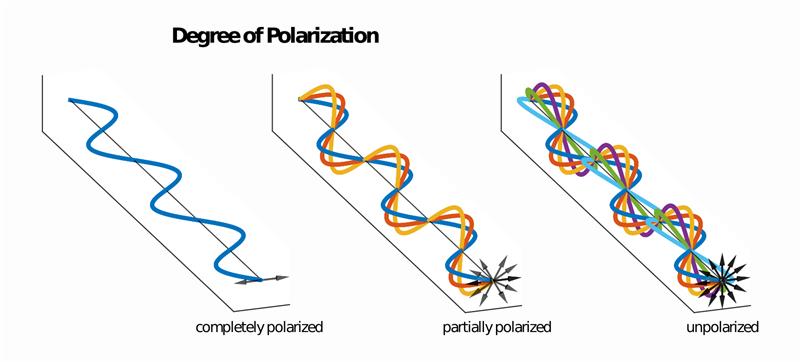
Figure 3: The degree of polarisation describes how many waves from a source are oscillating in the same direction. If they all have the same angle (left), the light is completely polarised, if only some of them have the same or similar angle (centre), the light is partially polarised, and if none of the waves oscillate in the same direction (right), the light is unpolarised
Angle and degree
There are two descriptors of polarisation; angle and degree. The angle refers to the direction of oscillation, while the degree is a measure of the similarity between the geometry of a group of light waves. Aside from exceptional circumstances, most sources of light (emitters and reflectors) consist of many thousands or millions of light waves, each travelling on its own oscillating course through space. It is possible that all the waves could be oscillating in the same direction, or, to give the other extreme, they could all be oscillating in completely different directions, ie they could have a completely different angle of polarisation. The term ‘degree’ describes the spread of the angle of polarisation within a light source. If all waves from a source oscillate in the same direction (have the same angle), that light has a high degree of polarisation and if all the waves are oscillating in random directions, the light has a low degree of polarisation. We tend to describe that light as being unpolarised (figure 3).
To our human eyes, unpolarised and polarised light look exactly the same. We are not alone in our ‘polarisation-blindness’; with the exception of one single species of fish (the northern anchovy), vertebrate animals do not have polarisation vision. On the other hand, it is rare to find an invertebrate that cannot detect polarisation in at least some portion of its field of view. Most insects have compound eyes, which have a very different structure than our own camera-type eyes. Each eye is made up of thousands of individual units that each have their own optics and photoreceptor cells. The architecture of these eyes can provide an animal with the ability to perceive both the angle and the degree of polarisation of incoming light. Typically they have two populations of photoreceptors: one set is sensitive to horizontal and one to vertically polarised light. Just as our colour vision is based on an opponent model, where the output of different photoreceptor cell types are directly compared, invertebrate polarisation vision is based on the comparison of these two photoreceptors that are sensitive to orthogonal angles of polarised light. So how are these animals using their polarisation vision?
Polarised light is abundant in the natural environment, though it is not something we are necessarily aware of. Light that is reflected from smooth, flat surfaces like water tends to have a high degree of polarisation with a horizontal angle. The sky itself is also polarised. Light originating from the sun interacts with small particles in the Earth’s atmosphere during ‘scattering events’, which cause the light to become partially polarised. The result is a pattern of polarised light in the sky that varies predictably with time of day (figures 4 and 5). The third source of polarisation is from animals themselves, though this tends to be more common in marine, rather than terrestrial animals. For instance, both mantis shrimp and cuttlefish have structures on their bodies that control the polarisation of light.
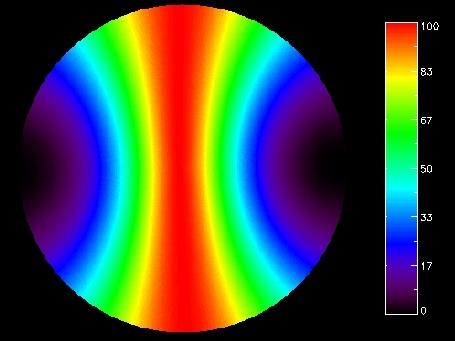
Figure 4: To our eyes, the clear sky just looks blue. However, an animal with polarisation vision would see a polarisation pattern alongside the blue. This shows the degree of polarisation of the sky, as if you were looking up. At this time of day, the most polarised region is a band across centre of the sky.

Figure 5: Polarisation can be seen as a dark region, in the upper left corner, if viewed through a polariser or a pair of Polaroid sunglasses.
Environmental polarisation
These sources of environmental polarisation are exploited by animals with polarisation vision in four main ways: for contrast enhancement, environmental assessment, navigation and for communication. Contrast enhancement is just a complex way of saying animals can use polarisation to make their vision clearer. In fact, that is exactly what we are doing when we wear Polaroid sunglasses. They have a filter that effectively blocks horizontally polarised light, thus reducing the glare from water or road surfaces. By reducing the glare, we are able to see the rest of the scene (ie the road and potential hazards like pedestrians) much more clearly that we otherwise would. It turns out that crabs also use ‘Polarised sunglasses’, just rather than donning a pair of Ray-Bans, theirs are built into the architecture of their eyes. Recall that invertebrate polarisation is based on a comparison between two populations of photoreceptors, one of which is sensitive to horizontal and the other to vertically oriented polarisation. Crabs, which tend to live on wet sand or mud, are constantly bombarded with horizontally polarised glare as light reflects off the wet surfaces (figure 6). To counteract that, their photoreceptor cells that absorb horizontally polarised light are much less sensitive than those that absorb vertical. This has the effect of reducing the amount of glare, which allows them to see their environment, and potential predators, much more clearly.

Figure 6: The light reflected from wet sand is horizontally polarised. In (a) the image is taken without a filter, while in (b) a polariser is used to block the horizontally polarised light, almost completely cutting out the glare
On the other hand, some animals actively seek out horizontally polarised light as it is associated with water. Many insects rely on water for at least part of their life cycle as well as for hydration. Insects perform many complex tasks with relatively small ‘processing power’. They do this by having certain preferences ‘hardwired’ into their neural circuitry. It is theorised this is why insects tend to get attracted to reflective artificial surfaces like solar panels, roads and even cars − they think it is water because they have evolved to associate that strong polarisation signature with water, and not man-made structures that turn out to be highly unsuitable for laying their eggs.
Polarisation can also be useful for navigation, especially when the sun may be obscured by intermittent cloud or tree cover. The desert ant has been shown to use the skylight polarisation pattern when returning to their home nest during foraging trips. It appears as though they use the band of polarisation as a ‘sky compass’, in much the same way as we would use a magnetic compass. However, there is still a mystery surrounding skylight polarisation navigation of this sort. The skylight polarisation pattern changes with time of day as the position of the sun changes, yet this does not seem to faze the ants. Despite this change, they are still able to use the pattern to find their way home, even if their foraging trip takes hours. It is clear they have some way of compensating for the change due to the time of day, but how such a mechanism works is still unclear. Other insects use the skylight polarisation pattern in a more simple way; to choose a heading. For instance, dung beetles, whose chief concern in life is to find a fresh pile of dung, form it into a ball and then roll it away to be enjoyed as a nutritious snack, use the skylight polarisation pattern to choose a heading. Unlike ants, they do not have a set home burrow, but will bury their dung-dinner and consume it underground. However, some dung beetles play dirty and, rather than rolling their own balls, will steal those already made by other beetles. It is imperative, then, for a hungry beetle to get as far away as fast as possible from the original dung pile, which means setting a course on a straight line. But traversing a straight line is pretty hard to do unless you have some sort of external cue. Beetles have been shown to use the sun’s position, local land marks and even the wind direction as well as the skylight polarisation pattern to help hasten their escape with dinner.
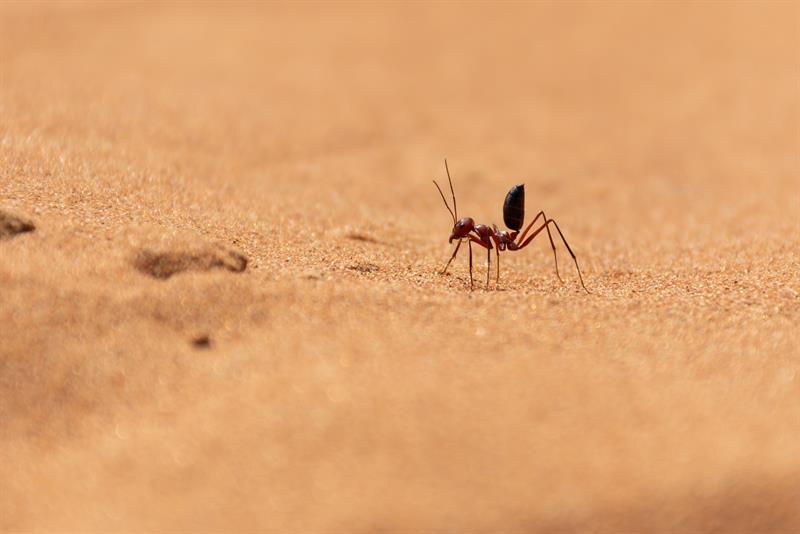
Both ants (above) and dung beetles (below) use the skylight polarisation pattern for navigation

Secret communication
Finally, animals can use polarisation for communication. In previous articles in this series I discussed how cuttlefish and mantis shrimp both use polarisation rather than colour for communication. There are two advantages to this, firstly due to water absorbing long-wavelength light more than short-wavelength, the colour of an underwater signal can vary with depth, becoming unreliable. Polarisation does not vary with depth. Secondly, under the right circumstances, it can be used as a ‘secret’ communication channel, meaning that an animal may be highly conspicuous to another individual from the same species, but inconspicuous or camouflaged to animals that may potentially be predators.
Engineers and scientists are taking inspiration from nature and beginning to make more and more use of polarisation imaging. Arguably, we have been doing so for a number of years with our use of polarised sunglasses, but our technology is becoming more sophisticated. Polarisation imaging is already being used in industry to examine surfaces and detect flaws, especially in objects made from transparent materials. Some autonomous robots are now being engineered to use the skylight polarisation pattern for navigation, taking inspiration directly from the insect world. Polarisation imaging has even been shown to be able to detect some forms of cancer because of the way the mutated cells reflect light compared to healthy cells, though this remains a very experimental diagnostic tool.
Just because we cannot perceive polarisation, it does not mean the polarisation state of light cannot be useful. Whether for navigation, environmental assessment, contrast enhancement or communication, animals have made use of polarisation information for a wide range of tasks. Engineers are now starting to follow suit, finding more and more ways in which polarisation can be useful for humans too.
